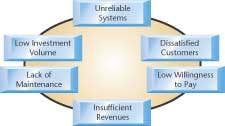Multi-utilities' advantages depend on regulatory competence
By Dieter Rothenberger
Deregulation of energy markets in many countries has led to the rise of the multi-utility concept as an entrepreneurial strategy to position a utility company and increase market shares. Judging whether the benefits outweigh the disadvantages of this multi-utility approach for all developing countries is not possible yet. The outcome of the cost-benefit analysis depends on local, regional and national circumstances, especially in regard to regulatory competence, which is a crucial point in developing countries.
The advantages of this concept include efficiency gains resulting from economies of scale and economies of scope that can reduce overall costs. Economies of scope are mainly relevant if the same utility company provides customers in the same region with water, energy or other services. From a customer's viewpoint, single sourcing of services offers advantages that include single billing, one-stop-shopping or tailor-made full service packages. These benefits, however, are coupled with difficulties in regulation and local or regional dependence. Global multi-utilities can aggravate these problems if they get involved in developing countries.
Regulation is one of the key topics concerning multi-utilities, both in industrialised and developing countries. Regulators in infrastructure sectors and especially in often monopolistic infrastructure sectors, such as water and wastewater services, are concerned about inefficiency in production which induces high cost, but also with suppliers extracting monopoly rents from their captive customers. To prevent this, regulators collect information about cost and pricing structures. The relationship between a regulator and the regulated company is always determined by asymmetric information, since the companies have better and more detailed knowledge about their data. This problem is aggravated in a multi-utility due to increased possibilities for cross-subsidies and a lack of transparency about the real cost allocation within and between sector activities.
These problems became apparent during the discussion of unbundling within the energy sectors after deregulation. Due to the still natural monopolies in electricity transmission and distribution, vertically integrated companies could shift cost from the competitive generation and sales sections to the operation of the grid. Instruments to improve transparency and reduce scope for internal transfers are the separation of the accounting sheets for generation, sales and distribution of electricity, or benchmarking of cost in the monopolistic sectors. Yet cost reallocation can never be fully prevented. A multi-utility service provider has even more opportunities to reallocate cost.
Also, how will the regulatory structure be set up? Separate sector regulators for the individual sector activities show advantages in terms of experience and specific knowledge about the sector. Nevertheless, co-ordination of individual regulatory bodies proves difficult within one sector alone, as can be seen in the United Kingdom water sector, co-ordination costs across sectors will even be much higher. A multi-sector regulator could be efficient in terms of internal co-ordination.
Two types of multi-utilities — the local and public multi-utility that is run and/or owned by the municipality, and the global private multi-utility, such as RWE of Germany or Vivendi Environnement of France — deliver services in the water, energy or other sectors in developing countries. Global multi-utilities like RWE or Vivendi seldom deliver more than one service in the same region, but public multi-utilities on municipal or regional levels combine various sectors within the same outreach.
One of these examples is Empresas Publicas de Medellin in Colombia, a highly successful multi-utility fully owned by the Municipality of Medellin. This company serves customers mainly in the metropolitan area of Medellin and the state of Antioqua, generating overall revenues of about US$ 841 million. While benefiting from the economies of scope, the multi-utility is trying to achieve transparency by maintaining separate balance sheets, profit and loss statements for each sector, and by transferring financial resources from one sector on commercial terms.
Examples with global multi-utilities involved include Vivendi contracts in Gabon and Morocco. In Gabon, Vivendi won a contract to serve the whole population of the country with water and electricity. This contract nets annual revenues of approximately g110 million. The Moroccan cities of Tangier, Tetouan and Rabat-Salé also awarded multi-utility contracts to Vivendi. These contracts are rather exceptional, but a growing demand for these kind of contracts call for a closer look on the advantages and disadvantages of multi-utilities from a developing world's perspective.
The cost reduction potential due to economies of scope and scale is probably much more important in developing countries than in industrialised countries because it improves affordability of basic services - a crucial point. Combining utility provision could also help to offset disadvantages from insufficient size of customer base in smaller and more remote communities, which proves even more advantageous in cases of private sector participation. Besides, since special managerial skills are often a scarce resource in developing countries, reduced numbers of specialists compared to the single utility model is of additional benefit.
One of the most important problems of water utility operation in developing countries is the handling of unpaid bills. Non-payment of water bills threatens the economic viability of the company and increases company risk; consequently interest rates rise, hampering infrastructure investments for system maintenance or service expansion. A vicious circle of low payment, reduced service reliability, dissatisfied customers and even lower willingness-to-pay for the water service is likely.
In this regard, multi-utility service providers can benefit from two advantages. First, credible threats to cut telecom or electricity services avoid the highly sensitive issue of cutting essential water services. Second, a short-term cross-subsidy from the electricity to the water sector could help to break the circle by financing required investments and thus improving services, which in turn lead to higher willingness-to-pay. Vivendi used this approach in Gabon. Water sales account only for 15% of the total revenue, but for 60% of all investment cost. The subsidy is achieved by adding an approximately one percent charge to the electricity tariff, but this is highly disputable in terms of transparent price setting, especially if - like it was the case in Gabon - the creation of a regulatory body was postponed for a long time after the contract had started.
Concerning the disadvantages, most regulatory issues are very relevant in developing countries, and many of them are actually being aggravated by particular circumstances. The involvement of multinational operators in water services made the difficulties to set up appropriate regulatory systems increasingly apparent. International experience, superior legal competence and negotiating skills of private companies often determine information asymmetry and bargaining power in favour of private water firms. Developing countries face another crucial drawback — the lack of competent regulatory staff — in addition to the difficulty in setting up an effective regulatory system. Since regulation is often considered to be a part of the government, regulatory agencies are often staffed with employees at local market rates. Lack of expertise especially in negotiations with international utility operators is frequently one of the main regulatory shortcomings. If these shortcomings are relevant in separated sector regulation, they become even more important in multi-utility regulation. The high complexity of multi-utility regulation is very likely an unsolvable obstacle in developing countries. The same holds for the issue of increasing political power of multi-utilities. Some differentiation must be made. Undesired political influence of local or regional multi-utilities can be prevented by strategic control in company boards by local stakeholders. Evidently, this is less feasible for global multi-utilities.
Conclusion
The benefits of increased efficiency due to economies of scope for locally active multi-utilities must be weighed against the difficulties in regulation and local or regional dependence. Global multi-utilities can aggravate these difficulties if they enter the market.
Creation of transparency in cost and price structures is a crucial point, but it requires highly developed regulatory skills and systems. Correct cost allocation is a basic requirement for appropriate price setting and cost coverage to run, maintain and possibly expand the infrastructure systems. Yet, while cross-subsidies contradict the perception of economic efficiency and pose difficulties for an effective regulation, a short-term re-allocation of resources from one sector to another can lead to high benefits, especially in developing countries.
So, in general, the jury is still out on this issue. Cost-benefit analyses depend on too many local, regional and national circumstances to make any decision for or against the multi-utility approach in developing countries. Most importantly, however, discussions of the benefits and disadvantages of this approach should help leaders in developing countries decide on the best approach to provide water services for their own citizens.
Author's noteFor more information, contact Dieter Rothenberger at the Centre for Innovation Research in the Utility Sector (CIRUS) in Kastanienbaum, Switzerland. Web: www.cirus.ch




